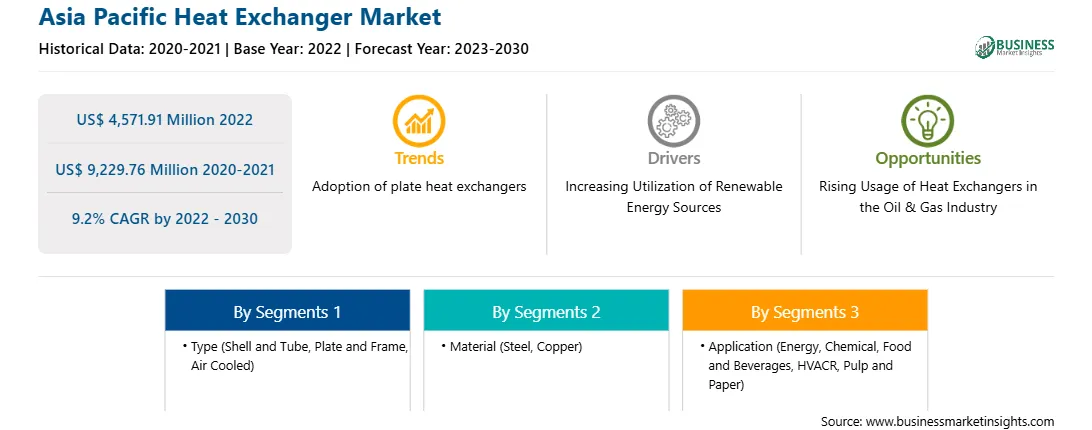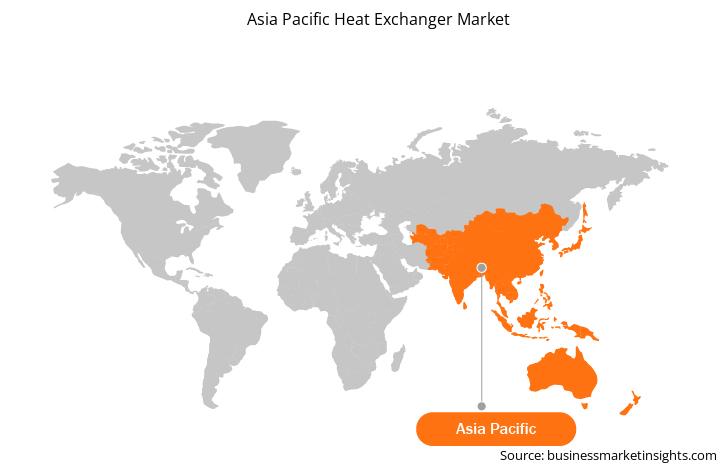The Asia Pacific heat exchanger market was valued at US$ 4,571.91 million in 2022 and is expected to reach US$ 9,229.76 million by 2030; it is estimated to grow at a CAGR of 9.2% from 2022 to 2030.
Integration of 3D Printing Technology with Heat Exchangers Fuel the Asia Pacific Heat Exchanger Market
3D printing or additive manufacturing is the development of a three-dimensional object from a digital file. The demand for 3D printing solutions is rising owing to advantages such as flexible design, rapid prototyping, print of demand, lightweight and robust parts, faster design and customized production, minimum waste, cost-effectiveness, and environment friendly. In addition, the rising awareness worldwide to use environment-friendly solutions and associated GHG emissions are encouraging heat exchanger providers to use this advancing technology to produce new products to meet the demand from various end user applications. The growing need for efficient heat exchangers in crucial applications such as power generation systems, consumer electronics, and food and beverage manufacturing facilities contribute to the adoption of 3D printing technology. Thus, the integration of 3D printing technology with heat exchangers is likely to create opportunities for market players to meet the growing demand from various end user applications during the forecast period.
Asia Pacific Heat Exchanger Market Overview
The Asia Pacific heat exchanger market is categorized into Australia, China, Japan, India, South Korea, Malaysia, Taiwan, and the Rest of Asia Pacific. The growing market is prominently attributed to the expansion of LNG imports led by China and India. Furthermore, the rising investment in the oil & gas industry will propel oil and gas production. As per the Shell LNG Outlook 2021, the LNG demand across the globe is expected to reach 700 million tons by 2040, and the natural gas demand is expected to grow strongly in Asia Pacific countries, generating the demand for gas production. With the rise in population and industrial growth, Asia Pacific witnessed increased energy demand. For instance, according to IEA, Southeast Asia's energy demand grew by an average of 3% every year from 2000 to 2020. It is further expected to grow by an average of 5% every year till 2030. Such a rise in demand in the region made the government expand its oil production units by introducing new refineries and expanding the production capacity of the existing oil refineries. As per the Energy Information Administration (EIA), at least nine refineries projects are expected to be completed by the end of 2030 in Asia and the Middle East. The rise in oil production generates the need for heat exchangers in the plants and refineries, which further fuels its market growth in the region.
Asia Pacific Heat Exchanger Market Revenue and Forecast to 2030 (US$ Million)
Strategic insights for the Asia Pacific Heat Exchanger provides data-driven analysis of the industry landscape, including current trends, key players, and regional nuances. These insights offer actionable recommendations, enabling readers to differentiate themselves from competitors by identifying untapped segments or developing unique value propositions. Leveraging data analytics, these insights help industry players anticipate the market shifts, whether investors, manufacturers, or other stakeholders. A future-oriented perspective is essential, helping stakeholders anticipate market shifts and position themselves for long-term success in this dynamic region. Ultimately, effective strategic insights empower readers to make informed decisions that drive profitability and achieve their business objectives within the market.

| Report Attribute | Details |
|---|---|
| Market size in 2022 | US$ 4,571.91 Million |
| Market Size by 2030 | US$ 9,229.76 Million |
| Global CAGR (2022 - 2030) | 9.2% |
| Historical Data | 2020-2021 |
| Forecast period | 2023-2030 |
| Segments Covered |
By Type
|
| Regions and Countries Covered | Asia-Pacific
|
| Market leaders and key company profiles |
The geographic scope of the Asia Pacific Heat Exchanger refers to the specific areas in which a business operates and competes. Understanding local distinctions, such as diverse consumer preferences (e.g., demand for specific plug types or battery backup durations), varying economic conditions, and regulatory environments, is crucial for tailoring strategies to specific markets. Businesses can expand their reach by identifying underserved areas or adapting their offerings to meet local demands. A clear market focus allows for more effective resource allocation, targeted marketing campaigns, and better positioning against local competitors, ultimately driving growth in those targeted areas.

1. Alfa Laval AB
2. API Heat Transfer Inc
3. Chart Industries Inc
4. Danfoss AS
5. Guntner GmbH & Co KG
6. Hisaka Works Ltd
7. Johnson Controls International Plc
8. Kelvion Holding GmbH
9. Larsen & Toubro Ltd
10. Xylem Inc
The Asia Pacific Heat Exchanger Market is valued at US$ 4,571.91 Million in 2022, it is projected to reach US$ 9,229.76 Million by 2030.
As per our report Asia Pacific Heat Exchanger Market, the market size is valued at US$ 4,571.91 Million in 2022, projecting it to reach US$ 9,229.76 Million by 2030. This translates to a CAGR of approximately 9.2% during the forecast period.
The Asia Pacific Heat Exchanger Market report typically cover these key segments-
The historic period, base year, and forecast period can vary slightly depending on the specific market research report. However, for the Asia Pacific Heat Exchanger Market report:
The Asia Pacific Heat Exchanger Market is populated by several key players, each contributing to its growth and innovation. Some of the major players include:
The Asia Pacific Heat Exchanger Market report is valuable for diverse stakeholders, including:
Essentially, anyone involved in or considering involvement in the Asia Pacific Heat Exchanger Market value chain can benefit from the information contained in a comprehensive market report.